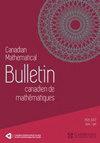外代数的拟对称调和
IF 0.4
4区 数学
Q3 MATHEMATICS
Canadian Mathematical Bulletin-Bulletin Canadien De Mathematiques
Pub Date : 2022-06-04
DOI:10.4153/S0008439523000024
引用次数: 0
摘要
摘要我们研究了n个反共轭(费米子)变量中的拟对称多项式环。设$R_n$表示n个反交换变量中的多项式环。本文的主要结果表明了关于反交换变量中拟对称多项式的以下有趣事实:(1)$R_n$中的拟对称多项式形成了$R_n]的交换子代数。(2) 存在$R_n$与理想$I_n$的商的基础,理想$I_n$由$R_n$中的准对称多项式生成,该多项式由投票序列索引。商的希尔伯特级数由$$\beargin{align*}\text给出{Hilb}_{R_n/I_n}(q)=\sum_{k=0}^{\lfloor{n/2}\rfloor}f^{(n-k,k)}q^k\,\end{align*}$$其中$f^{。(3) 由打破投票条件的序列索引的拟对称多项式生成的理想有一个基础。本文章由计算机程序翻译,如有差异,请以英文原文为准。
Quasisymmetric harmonics of the exterior algebra
Abstract We study the ring of quasisymmetric polynomials in n anticommuting (fermionic) variables. Let
$R_n$
denote the ring of polynomials in n anticommuting variables. The main results of this paper show the following interesting facts about quasisymmetric polynomials in anticommuting variables: (1) The quasisymmetric polynomials in
$R_n$
form a commutative subalgebra of
$R_n$
. (2) There is a basis of the quotient of
$R_n$
by the ideal
$I_n$
generated by the quasisymmetric polynomials in
$R_n$
that is indexed by ballot sequences. The Hilbert series of the quotient is given by
$$ \begin{align*}\text{Hilb}_{R_n/I_n}(q) = \sum_{k=0}^{\lfloor{n/2}\rfloor} f^{(n-k,k)} q^k\,,\end{align*} $$
where
$f^{(n-k,k)}$
is the number of standard tableaux of shape
$(n-k,k)$
. (3) There is a basis of the ideal generated by quasisymmetric polynomials that is indexed by sequences that break the ballot condition.
求助全文
通过发布文献求助,成功后即可免费获取论文全文。
去求助
来源期刊
CiteScore
1.30
自引率
0.00%
发文量
68
审稿时长
24 months
期刊介绍:
The Canadian Mathematical Bulletin was established in 1958 to publish original, high-quality research papers in all branches of mathematics and to accommodate the growing demand for shorter research papers. The Bulletin is a companion publication to the Canadian Journal of Mathematics that publishes longer papers. New research papers are published continuously online and collated into print issues four times each year.
To be submitted to the Bulletin, papers should be at most 18 pages long and may be written in English or in French. Longer papers should be submitted to the Canadian Journal of Mathematics.
Fondé en 1958, le Bulletin canadien de mathématiques (BCM) publie des articles d’avant-garde et de grande qualité dans toutes les branches des mathématiques, de même que pour répondre à la demande croissante d’articles scientifiques plus brefs. Le BCM se veut une publication complémentaire au Journal canadien de mathématiques, qui publie de longs articles. En ligne, il propose constamment de nouveaux articles de recherche, puis les réunit dans des numéros imprimés quatre fois par année.
Les textes présentés au BCM doivent compter au plus 18 pages et être rédigés en anglais ou en français. C’est le Journal canadien de mathématiques qui reçoit les articles plus longs.

 求助内容:
求助内容: 应助结果提醒方式:
应助结果提醒方式:


